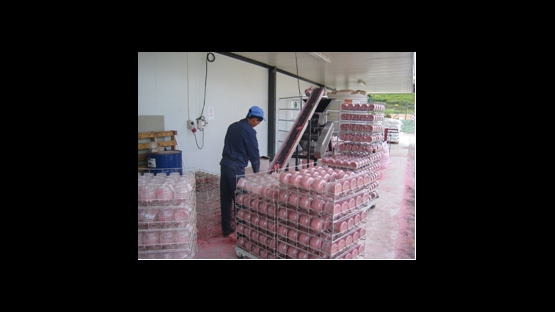Some of the Most Successful IAEA/TC Projects in the Field of Insect Pest Control in Africa
South Africa's Western Cape Province has a highly developed fruit export sector. However, the use of insecticides has become increasingly difficult due to pest resistance, environmental problems, legal restrictions and phytosanitary barriers to insecticide residues and larvae in export fruits (See Figure 1).
A pilot IAEA's project in the table grape producing Hex River Valley, SAF/5/002, 'Sterile Insect Technique Integrated Management of Fruit Fly' (1997-2003), has shown the sterile insect technique (SIT) to be effective to suppress the Mediterranean fruit fly, resulting in reduced fruit fly control costs and fruit losses, reductions in the rejection of export shipments of table grapes, and a reduced insecticide usage.
In view of this successful demonstration, the Government transferred the technology to a public-private partnership under which a company, Africa SIT,has been selling the sterile insects and the monitoring and release services to the fruit industry. This initiative is being expanded to other fruit-producing valleys with the recent inauguration of a larger mass rearing facility with a capacity to produce at least 50 million per week.
The follow-up IAEA national project SAF/5/007, 'Expanding the Use of the Sterile Insect Technique against Fruit Pests in the Western and Northern Cape' (2003-2009) had the objective to expand the integration of the SIT to include not only other fruit production areas, but gradually also other insect pests besides the Mediterranean fruit fly, such as the Codling Moth on apples and pears, the False Codling Moth on citrus and other crops, and Sugarcane Borers on sugarcane.
Through the collaboration of the Technical Cooperation with the IAEA and FAO, the United States Department. of Agriculture, and the Agricultural Research Council (ARC) and Institute for Deciduous Fruit, Vines and Wine and the Deciduous Fruit Producers Trust in South Africa, the SIT was first developed and applied against the False Codling Moth, a major pest of citrus, which has become insecticide-resistant.
After a successful pilot phase, this component of the project was also transferred to the private sector under a new company called Xsit, which has entered the operational phase, including the construction of a large moth mass rearing facility (See Figure 2) as a result of the IAEA technology transfer.
Most of citrus for export in the Western Cape Province is now under area-wide integrated SIT application, and expansion is foreseen to other citrus areas in other provinces. The citrus export industry was saved from this devastating insecticide resistant pest, and thousands of job losses were avoided in the Western Cape Province.
Through the implementation of project SAF/5/007 False Codling Moth SIT is now on a very firm footing in South Africa, having also improved the sustainability of fruit production and exports, and reduced fruit losses and insecticide use in the Western Cape Province.
Work is ongoing to assess the potential of integrating the SIT against Sugarcane Borers on sugarcane, as well as to consolidate Codling Moth management in support of the apple and pear export industries.
The technical support provided has been highly valued by the Government and private-sector and continues supporting the expansion to other areas. The achievements have been so convincing economically and environmentally to the private sector, that the two companies were established under public-private partnerships with the fruit industry, and a third one will be established soon. This assures sustainability of activities after the end of the TC project.


